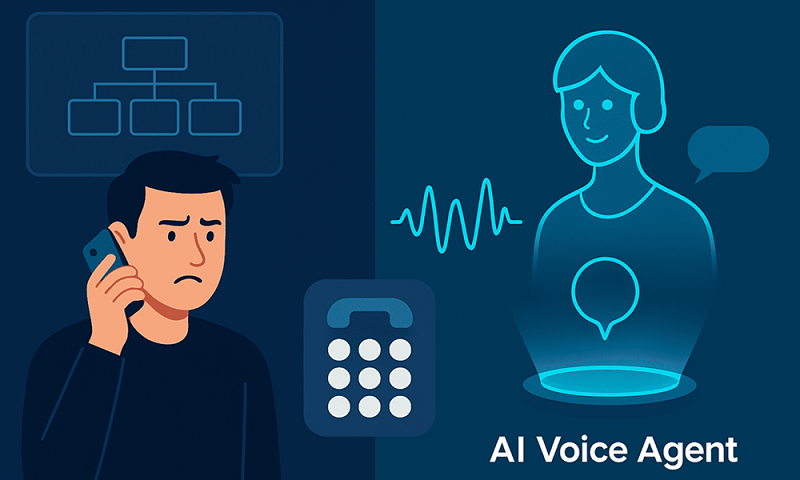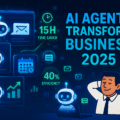Voice AI just got a major upgrade. OpenAI’s Realtime API launched with speech-to-speech capabilities that sound completely natural. This isn’t another robotic chatbot – it’s AI that speaks and responds like a human.
Quick Answer: OpenAI Realtime API enables businesses to create voice AI agents that handle phone calls, customer service, and sales conversations with human-like speech quality. The technology costs $6 per hour of audio and can replace expensive call center operations.
Business owners are already using this technology to automate phone support, qualify sales leads, and provide 24/7 customer assistance. The results? Reduced costs, faster response times, and customers who can’t tell they’re talking to AI.
This guide shows you exactly how OpenAI Realtime API works and practical ways to implement voice AI in your business today.
What Makes OpenAI Realtime API Different
Traditional voice AI required multiple steps: speech-to-text, text processing, and then text-to-speech. Each step added delays and made conversations feel unnatural.
OpenAI Realtime API works differently. It processes speech directly without converting to text first. This creates natural conversations with human-like timing, interruptions, and emotional responses.
Key Breakthrough Features
- Natural Speech Flow: AI responds with appropriate pauses, “ums,” and conversational rhythm that sounds completely human.
- Real-Time Interruption: Customers can interrupt the AI mid-sentence, just like normal conversations. The AI adapts instantly without confusion.
- Emotional Recognition: The system detects customer emotions (frustration, excitement, confusion) and adjusts its tone accordingly.
- Multiple Languages: Built-in support for 50+ languages without additional setup or training.
- Image Understanding: Voice AI can analyze images customers send during calls, perfect for technical support scenarios.
Business Applications That Drive ROI
Customer Service Automation
Replace expensive call centers with AI agents that handle 80% of customer inquiries automatically.
Implementation Example: A software company deployed voice AI for technical support. The system handles password resets, account questions, and basic troubleshooting. Result: 70% reduction in human agent workload.
Setup Process:
- Define common customer scenarios and responses
- Train AI on your product knowledge base
- Set escalation rules for complex issues
- Monitor and refine based on real interactions
Expected ROI: $2000-4000 monthly savings per replaced agent
Sales Lead Qualification
AI voice agents call leads, ask qualifying questions, and schedule appointments with promising prospects.
Real-World Results: A real estate agency uses voice AI to call website leads within 5 minutes. The AI qualifies budget, timeline, and property preferences before booking appointments. Sales conversion increased 40% due to faster response times.
Key Benefits:
- Immediate lead response (no more missed opportunities)
- Consistent qualification process
- 24/7 availability for different time zones
- Detailed conversation summaries for sales teams
Appointment Scheduling and Management
Voice AI handles appointment booking, confirmations, and rescheduling without human intervention.
Business Impact: A dental practice implemented voice AI for appointment management. The system confirms appointments, handles rescheduling requests, and sends reminder calls. Result: 35% reduction in no-shows and 20 hours weekly saved on administrative tasks.
Technical Implementation Guide
Getting Started Requirements
- API Access: Sign up for OpenAI Realtime API access (currently $6/hour of audio processing)
- Technical Skills: Basic programming knowledge or developer support for integration
- Infrastructure: Cloud hosting capable of handling real-time audio streaming
- Integration Options: Direct API implementation or third-party platforms like Voximplant or Twilio
Step-by-Step Setup Process
Day 1-3: Planning and Design
- Map current voice interaction workflows
- Identify automation opportunities
- Design conversation flows and responses
- Set up development environment
Day 4-7: Initial Implementation
- Configure API connections and authentication
- Build basic conversation logic
- Test audio quality and response timing
- Set up escalation procedures for complex scenarios
8-14 Day: Testing and Refinement
- Conduct extensive testing with real scenarios
- Refine conversation flows based on test results
- Optimize response quality and timing
- Train team on monitoring and management procedures
Day 15+: Launch and Optimization
- Deploy to production with limited scope
- Monitor performance and customer feedback
- Expand capabilities based on success metrics
- Scale to additional use cases gradually
Integration Best Practices
- Start Small: Begin with simple, high-volume scenarios like appointment confirmation or basic information requests.
- Maintain Human Backup: Always provide easy escalation to human agents for complex situations.
- Monitor Quality: Regularly review conversation recordings to ensure AI maintains appropriate responses.
- Update Regularly: Continuously add new scenarios and responses based on actual customer interactions.
Also Read:
Top 10 Small Business Automation Strategies to Save 20+ hours Weekly
AI Agents for Business: Complete 2025 Guide
Cost Analysis: Voice AI vs Traditional Solutions

Traditional Call Center Costs
- Human Agents: $3000-5000 monthly per full-time agent
- Phone Systems: $50-200 monthly per line
- Management Overhead: 20-30% additional costs
- Training: $500-1000 per new agent
- Total Monthly Cost: $4000-7000 per agent
OpenAI Realtime API Costs
- API Usage: $6 per hour of audio processing
- Development Setup: $2000-5000 one-time cost
- Hosting/Infrastructure: $100-500 monthly
- Maintenance: $500-1000 monthly
- Total Monthly Cost: $1000-2500 for unlimited calls
Break-Even Analysis: Most businesses see positive ROI within 60-90 days of implementation.
Real Business Success Stories
E-commerce Customer Support
Challenge: Online retailer receiving 500+ daily calls about orders, returns, and product questions.
Solution: Voice AI handles order status, return processes, and basic product information. Complex issues escalate to human agents with full conversation context.
Results:
- 75% of calls handled automatically
- Response time improved from 8 minutes to immediate
- Customer satisfaction increased from 3.2 to 4.5/5
- Monthly savings: $8000 in reduced staffing costs
Healthcare Appointment Management
Challenge: Medical practice spending 15 hours weekly on appointment scheduling, confirmations, and rescheduling.
Solution: Voice AI manages entire appointment lifecycle, integrates with practice management software, and handles insurance verification.
Results:
- 90% automation of scheduling tasks
- No-show rate decreased from 25% to 12%
- Staff time redirected to patient care
- Revenue increase: $3000 monthly from better schedule optimization
B2B Sales Prospecting
Challenge: Technology company struggling to contact and qualify leads quickly enough to maintain competitive advantage.
Solution: Voice AI calls leads within 2 minutes of form submission, qualifies budget and timeline, and schedules demos with qualified prospects.
Results:
- Lead response time: 8 hours to 2 minutes
- Qualification rate improved 60%
- Sales team focuses only on qualified prospects
- Revenue increase: $25,000 monthly from improved lead conversion
Common Implementation Challenges
Technical Hurdles
Audio Quality Issues: Poor internet connections can affect voice clarity. Solution: Implement quality monitoring and automatic switching to backup connections.
Integration Complexity: Connecting with existing business systems requires careful planning. Solution: Start with simple integrations and expand gradually.
Latency Problems: Delays in responses break conversational flow. Solution: Optimize server locations and use content delivery networks.
Business Process Challenges
Staff Resistance: Team members may fear job replacement. Solution: Position AI as assistant technology that handles routine tasks while humans focus on complex problem-solving.
Customer Acceptance: Some customers prefer human interaction. Solution: Always offer easy transfer to human agents and be transparent about AI usage.
Quality Control: Maintaining consistent service quality requires ongoing monitoring. Solution: Implement regular conversation review processes and continuous training updates.
Future-Proofing Your Voice AI Investment

Emerging Capabilities
- Predictive Conversations: AI will anticipate customer needs based on previous interactions and proactively address concerns.
- Multi-Modal Integration: Voice AI will seamlessly work with video, chat, and screen sharing for comprehensive customer support.
- Advanced Emotional Intelligence: Future updates will provide more sophisticated emotion detection and appropriate responses.
Strategic Planning
- Scalability Preparation: Design your voice AI system to handle growth without major infrastructure changes.
- Data Collection: Capture conversation analytics to improve AI performance and identify new automation opportunities.
- Competitive Advantage: Early adopters gain significant advantages in customer service quality and cost efficiency.
Getting Started Checklist
Immediate Actions (This Week)
- [ ] Sign up for OpenAI Realtime API access
- [ ] Identify your highest-volume, most repetitive voice interactions
- [ ] Calculate potential ROI based on current call center costs
- [ ] Research integration options for your existing systems
Short-Term Planning (Next 30 Days)
- [ ] Design conversation flows for top 3 use cases
- [ ] Set up development and testing environment
- [ ] Create escalation procedures for complex scenarios
- [ ] Train team on voice AI capabilities and limitations
Long-Term Strategy (Next 90 Days)
- [ ] Launch pilot program with limited scope
- [ ] Monitor performance and gather customer feedback
- [ ] Refine AI responses based on real interactions
- [ ] Plan expansion to additional use cases
Measuring Success: Key Metrics
Operational Metrics
- Call Resolution Rate: Target 70-80% of calls handled without human intervention
- Response Time: Measure average time from call start to issue resolution
- Customer Satisfaction: Track ratings before and after AI implementation
- Cost Per Call: Calculate total costs divided by calls handled
Business Impact Metrics
- Staff Time Savings: Hours redirected from routine calls to strategic tasks
- Revenue Impact: Increased sales from faster lead response and better customer service
- Scalability Improvement: Ability to handle call volume spikes without additional staffing
- Competitive Advantage: Market positioning benefits from superior customer service capabilities
Conclusion: The Voice AI Opportunity
OpenAI Realtime API represents a fundamental shift in business communication technology. Companies implementing voice AI today gain significant competitive advantages through reduced costs, improved customer service, and enhanced scalability.
The technology has matured beyond experimental phase into practical business solutions that deliver measurable ROI. Early adopters report substantial cost savings while improving customer satisfaction and operational efficiency.
Key Takeaways:
- Voice AI costs 60-70% less than traditional call centers
- Implementation typically achieves positive ROI within 90 days
- Customer satisfaction improves due to immediate response times
- Staff can focus on high-value activities instead of routine calls
The question isn’t whether to implement voice AI, but how quickly you can get started. Companies that delay adoption risk falling behind competitors who are already leveraging these capabilities for cost reduction and service improvement.
Start with a single use case, measure results, and expand based on success. The investment in voice AI technology today positions your business for continued growth and competitive advantage in an increasingly automated marketplace.
Next Step: Contact OpenAI to request Realtime API access and begin planning your voice AI implementation strategy.
About XonixLabs: We help businesses implement cutting-edge AI solutions that drive measurable results. Our team specializes in voice AI integration and provides comprehensive support from planning through deployment and optimization.


